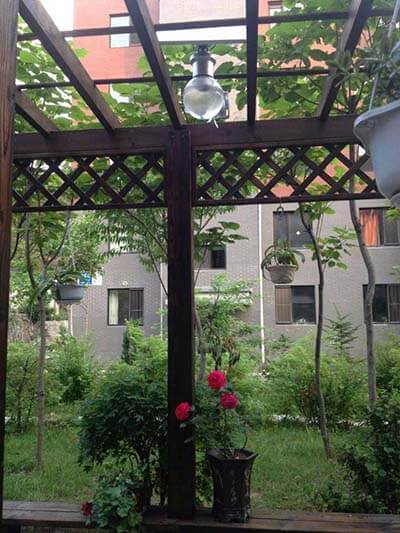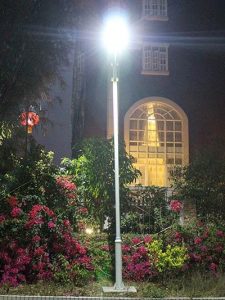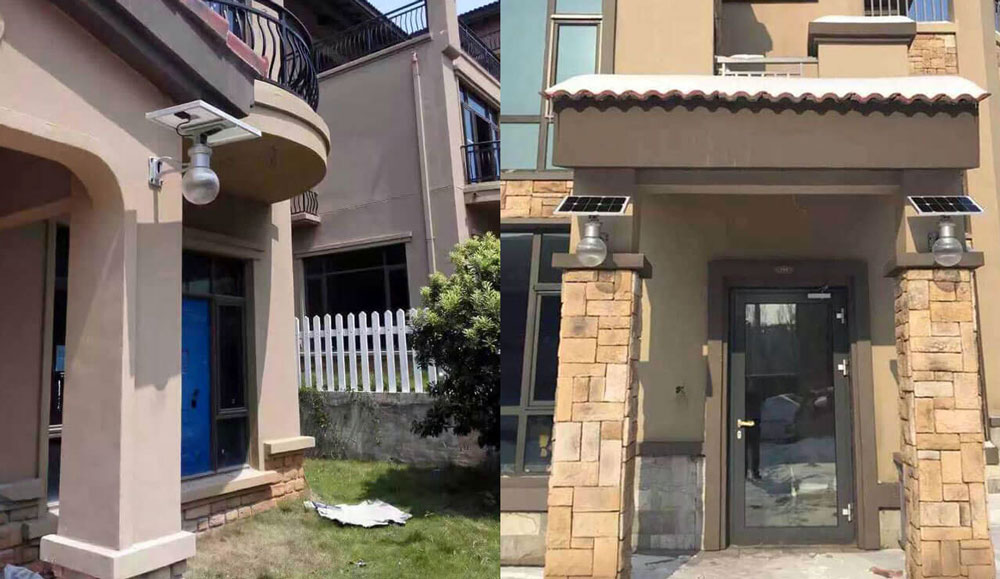Outdoor lighting makes perfect sense.
We landscape our yard and have ample space for entertaining. But you need bright enough lights to use these spaces at night. And besides, your garden can look just as spectacular from dusk onwards so long as its well-lit.
You have plenty of options as far as outdoor lighting is concerned – from bright globe lamps, ambient string lights, to stake lights and more. And thanks to their growing popularity and shrinking cost, garden solar lights are now on the menu, too.
What’s Inside A Solar-Powered Garden Light
Solar power technology has come a long way.
The technology has been around for centuries. But until recently, solar lights were lacking in the efficiency department and their use was strictly within the industrial sector. Decades ago, if you’re a homeowner looking to go solar, you better have deep pockets full of cash.
Fortunately, recent innovations reduced the cost and increased the efficiency of solar lights by leaps and bounds. They are now viable in residential areas, as proven by the growing popularity of solar street lights and garden lights.
Very quickly, let’s look at the stuff these lights are made of.
- Solar panel: The part of the unit which converts solar energy into electricity. Back in the day, you needed massive panels to generate enough electricity. Today, you can get away with much smaller panels thanks to their higher efficiency.
- Lighting fixture: The part that lights up. LEDs are now the go-to because they deliver higher lumens (brighter) while consuming less energy than other types of light.
- Rechargeable battery: Stores the energy captured by the panel during the day. Reaching full charge can take anywhere from eight to twelve hours.
- Pole or mounting brackets: Solar lights may come with a stake or a mounting bracket depending on the design. The former make for excellent ground lights, while the latter works best on sheds, walls, and entrances.
Did you notice anything?
No power cables included! It may not sound like much, but a wireless lighting set-up in your garden or patio is a huge time and money-saver.



5 Reasons To Choose Solar Lights For Your Home And Garden
A light is a light.
Whether solar-powered or otherwise, they all do the same job of providing illumination. So why should you go through the trouble of replacing what you have in the garden with solar lights? Here are five convincing reasons.
Environment-Friendly
Did you know that burning a ton of coal, the most common type of fossil fuel and also the most carbon intensive, emits 2.5 tons of carbon dioxide?
The impact of growing greenhouse gas emissions are far ranging – from increasing global temperatures, acidic rain, water and soil pollution, to physical damage to trees and plants.
The bad (or rather worse) news:
The demand for energy will never decline but these resources will, and the majority of the world still relies on fossil fuel for energy.
The good news, however:
Global CO2 emissions from fossil fuel combustion and industrial processes have stalled. Countries including China, United States, Japan, and Russia have even decreased their emissions. Thanks to renewable energy sources like solar power, these countries have reduced their dependency on fossil fuel.
With this in mind, it’s about time gardeners and homeowners join in on the action.
If you’re a gardener, you already have an affinity for Mother Nature, and using solar lights to illuminate your outdoor space is another simple way to show her that you care. The energy from the sun is not only free but also clean, unlike the fossil fuels we’ve relied on for so long.
Lower Cost Of Ownership
Let’s say you have four LED security floodlights with motion-sensors, the variety commonly used in entrances and dark areas in a yard. Each of these lighting fixtures consumes 28 watts per hour, and you keep it on for 11 hours, from 7PM to 6AM.
Using those numbers, each floodlight will consume 308 watts every day or 112.42 kWh annually. Multiply the kWh by $0.12 (average cost of kWh in the US), and we see that you’ll have to pay $13.49 to keep an LED security light running for a year.
To keep all four lights going, you need to shell out $53.96 every year.
The cost is unlikely to break the bank. But you’ve already paid for the lights. Do you really want to pay more to keep them lit?
With garden solar lights, you don’t have to.
The sun generates energy day-in and day-out and free of charge, while solar lights have everything they need to convert this energy into electricity. Meaning you will only have to pay for the unit and not for using it.
Even better, solar panel prices fall quicker than expected due to fierce competition and lower costs of components. You can rest easy knowing that replacing your outdoor lighting set-up won’t cost a fortune.
Boost Visual Appeal
Since all solar lights have pretty much the same parts, manufacturers stepped it up with different designs, shapes, and sizes to stand out from the competition.
Some models can even change colors or adjust their brightness to your liking, making them perfect for intimate gatherings.
Whether you’re celebrating a birthday party, entertaining surprise visitors, or taking your significant other to a date in your garden, today’s solar lights can help you set the mood and make the event extra memorable.
But solar lights are not just for aesthetics.
Models, such as Flat Series All-in-one, are excellent security lights. They are equipped with motion sensors and can have as much as 13,000 lumens to dissuade would-be crooks from targeting your property.
In a later section, we will look at some use cases for solar-powered lights in the garden.
Convenient And Easy To Maintain
Installing wired outdoor lights is no walk in the park.
Aside from the lighting fixture, you will need soils, potting mixes, electrical fittings, and a few meters of electrical wiring.
The process requires excavating the installation area in your garden, setting up the lights according to the manual, and carefully laying down the cables along the trenches.
Not to mention you need to keep a few things in mind, such as not plugging in the lights into the outlet before the lights are in place and leaving enough room when connecting or splitting wires.
If you don’t want to deal with all of that, you can hire a professional to do the job. But doing so can cost you $66 to $138 per fixture according to cost estimator app Homewyse.
Or, you can simply get garden solar lights and not have to worry about the installation. Since they don’t require a connection to the grid, installing them is as easy as boring the stake into the ground or mounting them onto the wall.
Note, too, that fire hazards due to faulty installation are out of the question.
On the other hand, wiping the panels clean with a dry cloth is all you need to do to maintain the unit in top condition. So you can spend more time caring for your herbs and shrubs and less time tidying up lighting fixtures.
And for added convenience, almost all solar lights automatically switch on at night and off at day. Meaning you can go about your day knowing they’ll turn on when needed.
Reliable Whatever The Weather
More than 3,000 power outage instances happen across the US every year. How will you light up your garden or patio when you get caught in one?
Outdoor lighting does more than add to your property’s appeal and environmental friendliness. They also make your home safer, too. The better nighttime visibility helps you and family members safely walk around the garden, while also detering break-ins and burglaries.
During a power outage, you and your family are stripped of all these safety perks.
Unless, of course, you’re using solar-powered lights. They get their power from the sun every day, and some can even perform efficiently with partial exposure to sunlight. Although, full sunlight is best whenever possible.
Some models, like the AirShip Series, even come with a detachable battery (for when you don’t get enough charge), LED light, and solar panels. The modular design allows homeowners to simply replace damaged or worn-out parts instead of buying a brand new unit.
The lights will also function regardless of the weather, with some home and garden models sporting an IP rating of 66. They are 100% protected against dust and particles while able to withstand powerful jets of water (ex: during heavy rain).

How And Where To Use Solar Lights
You’ve learned what’s inside them and the family and environment-friendly perks they afford. Now let’s take a look at some ideas and suggestions for using solar lights in outdoor spaces.
Light Up Pathways And Borders
Stake and stepping stone solar lights are the best fixtures for this job.
Pitch stake lights into the ground, and they’re good to go. Stepping stone lights, on the other hand, are smaller and a tad more complicated to install (you need to work with screws). But they sure are bright and can withstand daily foot traffic.
Boost Your Home’s Safety And Security
A well-illuminated pathway minimizes the chance of hard-to-see debris causing slips and falls. But solar lights are even better in this regard as they don’t have wires, leaving you with fewer tripping hazards to worry about.
Using motion-sensor solar lights (ex: spotlights and floodlights) is also highly recommended, especially for dark areas that receive little traffic. They turn on only after detecting movement, deterring unwanted visitors while saving the battery’s charge.
Drape Along Fence Lines And Decks
If pathways can make good use of solar lights, so do fence lines and decks. They are perfect decors for occasions such as birthdays or weddings. They also provide gentle, ambient light on deck railings and boundary walls alike.
In your garden, string lights can be draped around bushes or trees to make them stand out. Some solar string lights even change their colors so they suit the occasion.
Highlight A Centerpiece
Want to showcase the blossoming redbud in your garden? A little bit of uplighting can go a long way. Some stake solar lights have adjustable heads, which you can point towards the tree. About three or four of these lights are enough.
For other focal points in the yard, like a small fountain or seating nook, stepping stone lights will work better as their small size gives you more room for moving out and about.
Conclusion
The list of uses of garden solar lights above is anything but exhaustive. And you can bet that, as the industry grows and light manufacturers build better and more efficient models, gardeners and homeowners will find more creative uses.
